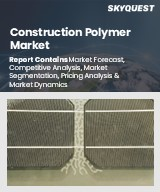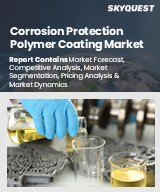
|
시장보고서
상품코드
1473819
폴리머 디스퍼전 시장 : 수지 유형별, 용도별, 예측(2024-2032년)Polymer Dispersions Market - By Resin Type (Acrylic Dispersions, Polyurethane Dispersions, Vinyl Dispersions, Styrene-Butadiene Dispersions), By Application & Forecast, 2024 - 2032 |
||||||
폴리머 디스퍼전 시장 규모는 친환경적이고 지속 가능한 코팅제, 접착제 및 페인트에 대한 수요 증가로 인해 2024년부터 2032년까지 연평균 5% 이상의 성장률을 보일 것으로 예상됩니다.
친환경 제품으로의 전환은 엄격한 규제와 지속가능성의 중요성에 대한 소비자의 인식이 높아짐에 따라 촉진되고 있습니다. 예를 들어, 2022년 12월 Mitsubishi Chemical Group은 Chukyo Yushi Co., Ltd.와 공동으로 식물 유래 폴리머 BioPBS(TM)를 사용한 생분해성 디스퍼전을 개발했습니다. 이 분산액은 Chukyo Yushi의 '생분해성 RESEM bio'의 새로운 포장재 등급으로 출시되었습니다.
또한, 폴리머 디스퍼전 배합의 기술 발전과 혁신으로 접착력, 색상 안정성, 내화학성 등의 성능 특성이 향상되고 있습니다. 특정 응용 분야 요구 사항을 충족하도록 특성을 조정한 새로운 폴리머 디스펜스 개발에 중점을 둔 R&D 노력도 제품 맞춤화 및 차별화를 촉진하고 있습니다.
고분자 분산 산업은 수지 유형, 용도 및 지역에 따라 분류됩니다.
수지 유형별로 보면, 비닐 디스퍼전 부문은 2032년까지 시장 규모가 크게 성장할 것으로 예상됩니다. 비닐 디스퍼전은 우수한 접착력, 유연성 및 내구성을 가지고 있어 코팅, 접착제 및 실란트에 이상적입니다. 또한, 지속가능성과 저 VOC 제품에 대한 수요 증가는 용매 기반 배합을 대체할 수 있는 수성 배합을 제공한다는 점에서 비닐 디스퍼전의 채택을 촉진하고 있습니다.
용도별로 보면, 인쇄 잉크 부문의 폴리머 디스퍼전 시장은 색상 안정성, 접착력 및 인쇄 품질 향상으로 인해 2024년부터 2032년까지 견고한 CAGR을 나타낼 것으로 예상됩니다. 포장, 출판, 섬유 및 기타 산업에서 고품질 인쇄에 대한 수요가 지속적으로 증가함에 따라 인쇄 잉크에 폴리머 디스퍼전의 채택이 크게 증가할 것으로 예상됩니다.
북미의 폴리머 디스퍼전 산업 점유율은 견조한 제조업과 자동차 부문으로 인해 2024년부터 2032년까지 큰 폭으로 성장할 것으로 예상됩니다. 이 지역에는 엄격한 환경 규제가 존재하기 때문에 솔벤트 기반 배합을 대체할 수 있는 친환경 수성 폴리머 디스퍼전의 채택이 장려되고 있습니다. 또한, 인프라 개발 프로젝트와 주택 건설로 인한 건설 산업의 확장은 건축용 코팅에 대한 폴리머 디스퍼전 수요를 더욱 증가시킬 것으로 예상됩니다.
목차
제1장 조사 방법과 조사 범위
제2장 주요 요약
제3장 업계 인사이트
- 생태계 분석
- 기술 및 혁신 상황
- 규제 상황
- 업계에 대한 영향요인
- 성장 촉진요인
- 업계의 잠재적 리스크&과제
- 성장 가능성 분석
- Porter's Five Forces 분석
- PESTEL 분석
제4장 경쟁 구도
- 기업 점유율 분석
- 경쟁 포지셔닝 매트릭스
- 전략 전망 매트릭스
제5장 시장 규모와 예측 : 수지 유형별, 2018년-2032년
- 주요 동향
- 아크릴 분산액
- 폴리우레탄 분산액
- 비닐 분산액
- 스티렌 부타디엔 분산액
- 기타
제6장 시장 규모와 예측 : 용도별, 2018년-2032년
- 주요 동향
- 장식·보호 코팅
- 접착제 및 실란트
- 종이
- 카펫·패브릭
- 인쇄 잉크
- 기타
제7장 시장 규모와 예측 : 지역별, 2018년-2032년
- 주요 동향
- 북미
- 미국
- 캐나다
- 유럽
- 독일
- 영국
- 프랑스
- 이탈리아
- 스페인
- 기타 유럽
- 아시아태평양
- 중국
- 인도
- 일본
- 한국
- 호주
- 기타 아시아태평양
- 라틴아메리카
- 브라질
- 멕시코
- 아르헨티나
- 기타 라틴아메리카
- 중동 및 아프리카
- 사우디아라비아
- 아랍에미리트(UAE)
- 남아프리카공화국
- 기타 중동 및 아프리카
제8장 기업 개요
- Arkema S.A.
- BASF SE
- Covestro AG
- Dow Chemical Company
- Eastman Chemical Company
- Evonik Industries AG
- Huntsman International LLC
- Lanxess AG
- Mitsubishi Chemical Corporation
- Mitsui Chemicals, Inc.
- PPG Industries, Inc.
- Sika AG
- Solvay SA
- Synthomer plc.
- Wacker Chemie AG
Polymer dispersions market size is anticipated to grow at over 5% CAGR between 2024 and 2032, driven by the increasing demand for eco-friendly and sustainable coatings, adhesives, and paints. This shift towards eco- friendly products is fueled by stringent regulations and growing consumer awareness regarding the importance of sustainability. For instance, in December 2022, the Mitsubishi Chemical Group developed a biodegradable dispersion solution with its plant-derived polymer BioPBS(TM) in collaboration with Chukyo Yushi Co., Ltd. This dispersion was introduced as a new grade for packaging materials for the latter's biodegradable RESEM bio.
Moreover, technological advancements and innovations in polymer dispersion formulations are enhancing performance characteristics, such as adhesion, color stability, and chemical resistance. The rising R&D efforts focusing on developing novel polymer dispersions with tailored properties to meet specific application requirements are also fostering product customization and differentiation
The polymer dispersion industry is segmented based on resin type, application and region.
In terms of resin type, the market value from the vinyl dispersion segment is anticipated to witness substantial growth through 2032, due to the versatility and wide-ranging applications across various industries. Vinyl dispersions offer excellent adhesion, flexibility, and durability, emerging ideal for use in coatings, adhesives, and sealants. Moreover, the growing demand for sustainability and low-VOC products is driving the adoption of vinyl dispersions as they provide a water-based alternative to solvent-based formulations.
With respect to application, the polymer dispersion market from the printing ink segment is projected to record robust CAGR from 2024 to 2032, as they offer improved color stability, adhesion, and print quality. As demand for high-quality printing continues to rise across industries, such as packaging, publishing, and textiles, the adoption of polymer dispersions in printing inks is expected to increase significantly.
North America polymer dispersion industry share will grow significantly between 2024 and 2032, attributed to the robust manufacturing and automotive sectors. The presence of stringent environmental regulations in the region is incentivizing the adoption of water-based polymer dispersions as eco-friendly alternatives to solvent-based formulations. Moreover, the expansion of the construction industry, driven by infrastructure development projects and residential construction will further boost the demand for polymer dispersions in architectural coatings.
Table of Contents
Chapter 1 Methodology & Scope
- 1.1 Market scope & definition
- 1.2 Base estimates & calculations
- 1.3 Forecast calculation
- 1.4 Data sources
- 1.4.1 Primary
- 1.4.2 Secondary
- 1.4.2.1 Paid sources
- 1.4.2.2 Public sources
Chapter 2 Executive Summary
- 2.1 Industry 360-degree synopsis
Chapter 3 Industry Insights
- 3.1 Industry ecosystem analysis
- 3.2 Technology & innovation landscape
- 3.3 Regulatory landscape
- 3.4 Industry impact forces
- 3.4.1 Growth drivers
- 3.4.1.1 Rising demand in end-user industries
- 3.4.1.2 Sustainability concerns and eco-friendly alternatives
- 3.4.1.3 Technological advancements and Innovation
- 3.4.2 Industry pitfalls & challenges
- 3.4.2.1 Fluctuating raw material prices
- 3.4.1 Growth drivers
- 3.5 Growth potential analysis
- 3.6 Porter's analysis
- 3.6.1 Supplier power
- 3.6.2 Buyer power
- 3.6.3 Threat of new entrants
- 3.6.4 Threat of substitutes
- 3.6.5 Industry rivalry
- 3.7 PESTEL analysis
Chapter 4 Competitive Landscape, 2023
- 4.1 Company market share analysis
- 4.2 Competitive positioning matrix
- 4.3 Strategic outlook matrix
Chapter 5 Market Size and Forecast, By Resin Type, 2018-2032 (USD Billion, Kilo Tons)
- 5.1 Key trends
- 5.2 Acrylic dispersion
- 5.3 Polyurethane dispersion
- 5.4 Vinyl dispersion
- 5.5 Styrene-butadiene dispersion
- 5.6 Other
Chapter 6 Market Size and Forecast, By Application, 2018-2032 (USD Billion, Kilo Tons)
- 6.1 Key trends
- 6.2 Decorative & protective coatings
- 6.3 Adhesives & sealants
- 6.4 Paper
- 6.5 Carpet & fabrics
- 6.6 Printing ink
- 6.7 Other
Chapter 7 Market Size and Forecast, By Region, 2018-2032 (USD Billion, Kilo Tons)
- 7.1 Key trends
- 7.2 North America
- 7.2.1 U.S.
- 7.2.2 Canada
- 7.3 Europe
- 7.3.1 Germany
- 7.3.2 UK
- 7.3.3 France
- 7.3.4 Italy
- 7.3.5 Spain
- 7.3.6 Rest of Europe
- 7.4 Asia Pacific
- 7.4.1 China
- 7.4.2 India
- 7.4.3 Japan
- 7.4.4 South Korea
- 7.4.5 Australia
- 7.4.6 Rest of Asia Pacific
- 7.5 Latin America
- 7.5.1 Brazil
- 7.5.2 Mexico
- 7.5.3 Argentina
- 7.5.4 Rest of Latin America
- 7.6 MEA
- 7.6.1 Saudi Arabia
- 7.6.2 UAE
- 7.6.3 South Africa
- 7.6.4 Rest of MEA
Chapter 8 Company Profiles
- 8.1 Arkema S.A.
- 8.2 BASF SE
- 8.3 Covestro AG
- 8.4 Dow Chemical Company
- 8.5 Eastman Chemical Company
- 8.6 Evonik Industries AG
- 8.7 Huntsman International LLC
- 8.8 Lanxess AG
- 8.9 Mitsubishi Chemical Corporation
- 8.10 Mitsui Chemicals, Inc.
- 8.11 PPG Industries, Inc.
- 8.12 Sika AG
- 8.13 Solvay SA
- 8.14 Synthomer plc.
- 8.15 Wacker Chemie AG



















